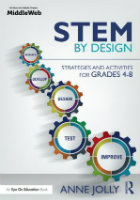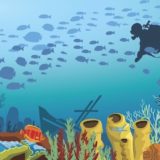Spying STEAM Projects from a Theatre Balcony
A MiddleWeb Blog

Now, if you’ve seen Les Mis, then you know that the sets for that show aren’t designed to be bright and glittery. Les Mis is about tragedy, pathos, and problems. The sets add important lighting, ambience, emotion, and life to the show – they draw you onto the stage itself and underscore the storyline and music.
The staging for this show became a source of constant interest and amazement for me. Scenes changed frequently – weaving in and out of the storyline and music seamlessly. They changed unobtrusively and appeared to spill from one scene directly into another as they accentuated the drama and music.
How? I didn’t know. I decided to investigate how the engineering worked to manipulate the sets so smoothly. Apparently, the sets were designed to move on a motorized base structure (a turntable with sets of tracks) and were hinged so that they could move in all directions, including up and down. The combined talent of the artists and engineers who crafted and constructed sets so that sections can move in and out and connect in creative ways is mind-boggling.
The magic of theatrical productions
For me, theatrical encounters are magic. As the Les Mis production continued, I realized that art and engineering had truly merged into a single being and were working together to create the beauty, poignancy, and power of the whole experience.
That, my fellow readers, is STEAM. In this project, art and engineering were inseparable. Beauty and function shared equal billing. This musical production needed to convey a story and mood through music and movement. Engineering was necessary and integral to making that happen. (Notice that I’m not even going into the instruments and sound design aspects of productions such as this. Engineering was everywhere!)
From the Fisher Theatre in Detroit
I’m assuming you’ve seen musicals and theatre drama, whether at a professional production like The Lion King or a local school play. It’s impossible to miss the integration of Art and Engineering on these occasions.
If (like me) you’ve wondered at times whether the acronym STEAM is a valid representation of a relationship between STEM and art – it certainly can be. But beware! Not every project billed as STEAM is truly a STEAM project in this integrated, interwoven sense.
Here’s my current definition: STEAM projects feature STEM challenges that cannot be solved or achieved without the A (arts). And vice versa. STEAM involves an intentional, necessary merger of art with STEM subjects to find solutions that bring meaning, life, learning, and/or enjoyment to people.
Where engineering meets art
You could make a case for art being part of all STEM projects simply because these projects generally involve drawing, sketching, using visuals, etc. Okay – it depends on your definition of what the A in STEAM entails. I’ve thought of STEAM like that myself. But that casual use of “art” doesn’t really qualify as the “A” in STEAM according to my ever-changing way of thinking about this issue.
Having kids work on a solution for an environmental challenge and adding an art connection such as drawing a picture of the solution doesn’t do it for me. Art, in that case, isn’t actually required for the solution but is thrown in so that we can say we added art. When the project requires both engineering and art for success, however – when the two truly marry and real learning occurs across all subjects – that’s a kind of STEAM I can embrace (and enjoy!).
Obviously, I’ve puzzled over the STEAM acronym for a while. (For example, look here, here, and here.) My editor’s patience with my STEAM posts is doubtless wearing thin (Sorry, John!), but my viewpoint is still developing. I’m not there yet. But I’m still mulling it over and learning.
What about STEAM Lessons, My Editor Wonders?
So much for lofty STEAM thoughts. Let’s get practical. What lesson plans are out there to involve kids in STEAM projects that marry art and STEM? Clearly theatre engineering is a starting point. We might come up with projects that apply engineering principles to design and develop safe, creative, and/or functional sets. Perhaps kids could design musical instruments or gadgets to produce particular sounds and effects. (Shakespeare always demands some device to produce a ghastly effect.)
On occasion I’ve seen engineering and theater “merge” by having kids use music and dance to act out some scientific idea – perhaps dramatically interpreting how electrons, protons, and neutrons combine to form a molecule. Sometimes students are asked to draw, dramatize, dance, or compose music to share a scientific concept. That’s cool, but where is the E? The engineering challenge? How does that require the application of current grade-level science and math content? I’m inclined to shake my head and discount that as true STEAM.
But let’s be fair to some other criteria in thinking about STEAM. Please take a look at this article, Science Theater as STEAM. The author offers other objectives that can be achieved through adding the arts: more permanent retention of knowledge, growing student enthusiasm for STEM, and teachers collaborating more closely, to mention three. So I guess I’m wondering – what’s your working definition/understanding of STEAM? The fact of the matter is, we may all be right – or wrong.
In my next blog post I plan to offer some STEAM lessons featuring my current favorite perception – the truest STEAM is an interdependent marriage of STEM and the arts to solve an engineering challenge. If you want to throw out some ideas, I’ll gratefully give them space.
Just for your students: Actor Gaten Matarazzo, then 11, offers a tour of the Broadway theater where he played Gavroche in 2014. From theatremania. Gaten now stars in Netflix’s Stranger Things.
_________________________________________________________________




































This is a marvelous take on STEM and/or STEAM education! I am a strong proponent of interdisciplinary learning and combining art/theater and literature with the sciences/math and engineering is great! Thanks so much!
Thank you, Ellen. I love the idea of spotlighting the interconnectedness of STEM and the arts. I particularly love theater and music, and love being able to marry these with STEM without compromising the integrity of either discipline.
Anne,
As a middle school English teacher who tries to incorporate STEAM projects into my classroom, the “A” is particularly important. I agree that one’s conception of this is going to depend on what “counts” for A. Maybe there needs to be a better distinction between “art as performance” vs. “art as process” when it comes to STEAM. In the example you gave about using a drawing in the final solution of an environmental challenge, it may not qualify as “art for performance” because art wasn’t necessitated in the final product. However, art may have been a integral, albeit necessary, part of the process of creating one’s solution (I’m thinking about students who use fundamental elements of art when brainstorming, planning, and developing solutions). Art can breakdown language barriers when collaborating or even in the production/performance phase of a challenge.
True, we need to be thoughtful about how art is being utilized in a challenge to call it “STEAM” and not just throw “draw, dance, sing, etc.” to “meet that criteria.” That said, I think those type of instructions in a challenge can meet the criteria of art as process and be fundamental to a student’s ability to develop a solution that “brings meaning, life, learning, and/or enjoyment to people.”
All that said, one example of a Spring STEAM project that I’ve been tackling in my classroom the past few years is how we engineer solutions to food security issues in communities. My students read about the history of fast food with the book Chew on This, listen to a couple of TedTalks, and watch the documentary Fed-Up, utilizing ELA annotation and analysis skills that we’ve worked on the whole year. This study gives us background into the issues. Students often point out that food is cultural which is difficult to change even if you magically provide for more food access for all in communities. We explore our own food culture and research where that culture came from (i.e. why do I use ketchup in many of my meals? My grandfather grew up in poverty & ketchup was what they used to season/give taste to their food which got passed down to me via my mom’s cooking.) Students write narratives about food in their own lives and decide how those narratives would be best used to share different perspectives on food with others in their class and community. They have construct cookbooks across classes that provide these narratives, research, and recipes. Some have filmed PSAs about food as well. We end with a Chopped Junior challenge in class where students have to make someone else’s recipe which they don’t know until the day of (I have received grants to provide an extensive pantry for this event.) An added issue is the fact that they make this all in English class with 1 microwave available :D. Students publish their cookbook and sell it in our community to support it ongoing (we’ve done this for the past 3 years). The arts are essential in not just their understanding of how to address this problem, but also in the way they derive a unique solution that not only impacts them but can and has impacted others in the community. Perhaps this challenge doesn’t fully meet the demands of engineering, but I believe that that it could if science and math teachers had students using their principles to determine/develop new recipes (how do different proportions of key ingredients that are in shortage due to coronavirus impact a classic family recipe) or ingredients (how can we incorporate a hybrid vegetable we develop in this recipe).
Thanks for sharing your thoughts on this topic,
Charlsie (I’m also in Alabama!)
Wow! What a well thought out and articulate response, Charlsie! A perfect answer for my question – what’s your working definition/understanding of STEAM?
I think you’re on to something with your suggestion that there needs to be a better distinction between “art as performance” vs. “art as process” when it comes to STEAM. If kids don’t develop the process skills, then the hoped-for performance isn’t going to happen. Teachers of all subjects can equip kids with valuable tools for thinking, innovating, caring, and problem-solving. I would say that your class definitely does that.
Developing new recipes for specific situations – perhaps substituting for key ingredients – would be a wonderful response. It could involve social studies (cultures), language arts (narratives, communcation), and perhaps visual arts (sketches of the food, or photos). That’s a well-rounded project that involves a number of subject areas and a set of skills that are useful in solving problems.
While it doesn’t meet all the STEM criteria from my perspective, it certainly develops kids with approaches and mindsets that can help them make STEM challenges successful.
You make a valid case for a broader definition of STEAM and I thank you so much for expanding my thinking! I’m glad you’re a fellow Alabamian. Please post again when you have an opinion on something I post.